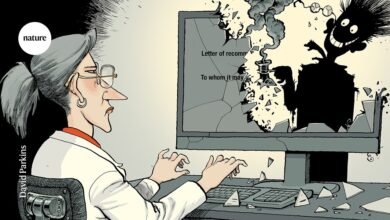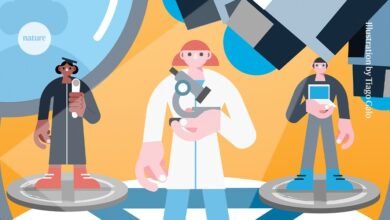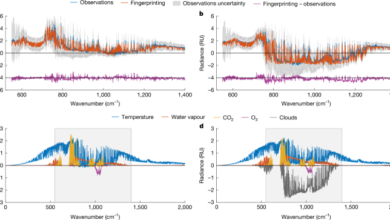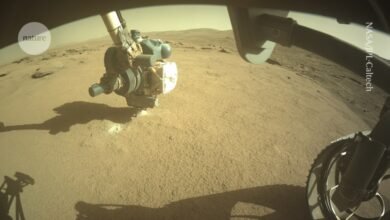The grassroots organizations continuing the fight for Ukrainian science
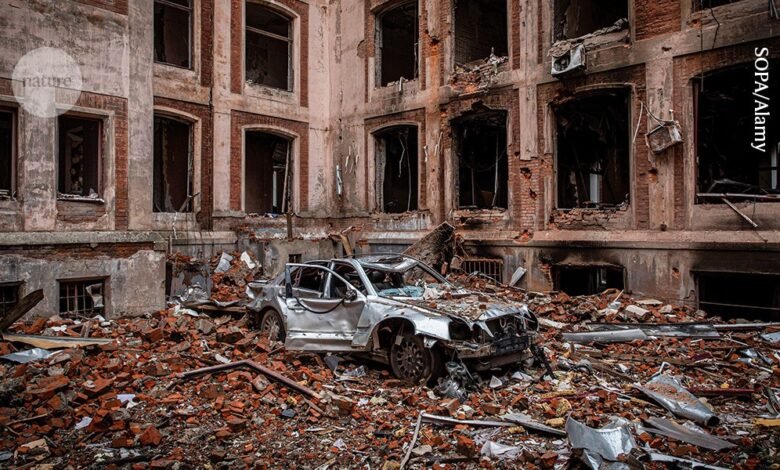

University buildings in Kharkiv and elsewhere have been damaged during the Russia-Ukraine conflict.Credit: SOPA/Alamy
In the weeks following Russia’s full-scale invasion of Ukraine in February 2022, Ukrainian policy researcher Yulia Bezvershenko, then at Stanford University in California, took part in a round table to discuss how to preserve science in her native country as the conflict escalated.
On the video call, organized by the Social and Human Sciences sector of the United Nations cultural organization UNESCO to assess the urgent needs of scientists and generate ideas to address them, Bezvershenko was struck by the lack of effective processes in place to protect research and scientific infrastructure. For example, as a later white paper detailed, Ukraine’s evacuation plan for scientific collections and specimens was from the Soviet era, and suggested that objects of value should be taken east through the Ural Mountains — not feasible in 2022, when the Russian army stood between Ukraine and those same mountains. “The instruments to support science at risk were mainly built during the Second World War,” says Bezvershenko, “and they are for a different situation.”
Also present at the round table were Kyrylo Beskorovainyi and Daria Kuzyava, co-founders of the Ukrainian online popular-science magazine Kunsht, as well as Yuriy Khalavka, who leads the chemistry department at Yuriy Fedkovych Chernivtsi National University in Ukraine. All three shared Bezvershenko’s concerns about their country’s lack of preparation and, in response, founded Science at Risk, an organization that documents the damage that has been done to Ukrainian science and looks at how responses to future crises can be more effective.
The Science at Risk website lists institutions that have been affected by the conflict, including details of damage to buildings and the price of any repairs. For example, 40,000,000 hryvnia (US$970,000) is needed to repair the damage done by missiles to the Institute of Mathematics of the National Academy of Sciences of Ukraine in Kyiv, the largest mathematical institution in Eastern Europe. The Radio Astronomy Institute of the National Academy of Sciences of Ukraine in Kharkiv requires around 50,000,000 hryvnia to replace and fix swathes of equipment.
Although each listing gives details of whom to contact to offer help, the goal is not to crowdfund support but to help people to understand the scale and impact of the destruction, says Bezvershenko. “Having round numbers — like saying 15% of research infrastructure is damaged — is nice for presentations and things, but it builds a wall between you and the real situation,” she says. “It’s hard to engage on that scale, but on a case-by-case situation you realize there are things you can do.”
Immediately after the team founded Science at Risk, it used grants of $45,400 from the US Embassy in Ukraine and $189,000 from the Alfred P. Sloan Foundation in New York City, to hire teams to visit Ukrainian research institutions, interview staff and analyse data. “We wanted to study how to preserve science at risk, how to rebuild it after the risk is over, and how to communicate it during this turbulence,” explains Beskorovainyi.
This research has since produced a series of white papers that the authors hope could be applied to crises elsewhere in the future, on subjects such as the role of citizen science, how to harness the power of the scientific diaspora, and how to transform Ukraine’s research and innovation system after the war. For example, a white paper entitled Preserving Museum, Archival, Library, and Scientific Collections During the War gives detailed recommendations, such as prioritizing which objects are of most value and which are most vulnerable during conflict.
Behind the data and analysis, however, there are individuals’ stories, which the team felt were important to share. To this end, Science at Risk has created an online database of Ukraine-based scientists and societies to help facilitate international support and collaboration.
Its website also hosts a bank of articles, each accompanied by vivid photos, that depict the harm done to individual researchers and their institutions. “Analytical work is just a part of the story,” says Khalavka, “you need some examples, some field cases, to make it more powerful in terms of spreading the word and explaining what’s going on and what should be changed.”
“From day, one our ambition was for this knowledge to be of use internationally,” says Beskorovainyi. “For that reason we define ‘risk’ broadly; it’s not only about war but also environmental crises, social crises, and we want to build such a centre that could inform others on all of those challenges and all of those threats to science.”
Coordinating offers of support
Two days after Russia’s full-scale invasion, Sanita Reinsone saw a glut of social-media posts from researchers around the world offering support for Ukrainian students and scholars, including everything from funding and sanctuary spaces to access to equipment. Recognizing that they needed to be collated in a single place, Reinsone started the #ScienceForUkraine account on X (formerly Twitter) on which she retweeted and catalogued all the offers.
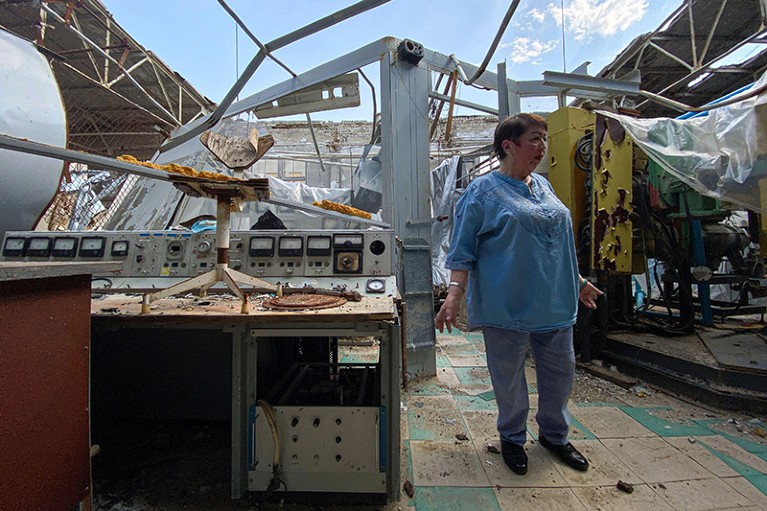
Buildings at the Kharkiv Institute of Physics and Technology were heavily damaged during a Russian attack.Credit: Oleksandr Brynza/AP/Alamy
But Reinsone, a digital-humanities researcher at the University of Latvia in Riga, realized almost immediately that the sheer number of offers necessitated a more stable platform. “On social networks, this information disappears very quickly, even if the #ScienceForUkraine account republishes it,” she says. “So, two days after creating the Twitter account, a very simple website was developed with a few filters and a map.”
The website meant that listings could be submitted directly to the platform, instead of the team having to scour Twitter, so the amount of offers began to grow exponentially. The day after the website launched, on 28 February 2022, the number of listings jumped from 38 to 190. A week later, there were more than 400; the next week, more than 800.
The number of volunteers helping to gather information about available support grew, too. “In a couple of days we were some six volunteers, and in two months we were around 100 volunteers from different countries,” says Reinsone. The volunteers also became more active, reaching out directly to universities and research institutions to see what support they could provide to Ukrainian researchers.
Among the key early additions to the team were Michael Rose, an innovation economist at the Max Planck Institute for Innovation and Competition in Munich, Germany, and Oleksandra Ivashchenko, a medical physicist at the University Medical Center Groningen in the Netherlands, who was born in Ukraine but left in 2012. Rose, Ivashchenko and Reinsone now work as the lead coordinators of #ScienceForUkraine’s global network of volunteers.
Although #ScienceForUkraine was inundated with offers at the start, Ivashchenko says support slowed as the war carried on. “By April 2022, we had 2,100 listings. Now, over two years later, we have only added around 1,200 more”. The sources and nature of support also changed. Initially, it was individuals and research groups who were willing to welcome researchers into their laboratory or work on joint funding applications, but within a few months much larger projects, involving governments and universities, were arranging scholarships and academic transfers, which allowed groups of students to continue their studies in a non-Ukranian university.
In August 2023, Reinsone, Ivashchenko and Rose registered #ScienceForUkraine as a non-governmental organization (NGO), allowing it to open a bank account and receive donations directly. The largest donation has been around €6,000 ($6,630) from the European Council of Academies of Applied Sciences, Technologies and Engineering, says Reinsone. “With other donations amounting to around €2,000 in total”.
#ScienceForUkraine remains a volunteer organization and none of this money has been used to pay staff. Instead, it has helped to ensure that the organization has a sustainable future and enabled it to initiate projects that align with its new aims. “As an NGO, we try to focus on aspects that are maybe less urgent and vital on an individual basis than when people needed shelter, but that are vital for the long-term survival of the Ukrainian scientific community,” says Ivashchenko.
One key initiative it has launched is a micro travel grants programme, which provides scientists working at Ukrainian research institutes with up to €500 to attend international events. “Many conferences were offering free spaces to Ukrainian scientists, but flights and accommodation were beyond what many could afford,” Ivashchenko explains. This is valuable on an individual level but also ensures that Ukrainian universities can maintain a presence at international events. So far, six researchers have been awarded grants.
An analysis by #ScienceForUkraine highlighted the importance of strengthening science in the country. It showed that, despite the vast majority of scientists (between 88–95% by recent estimates) remaining in Ukraine, only 5% of the offers of support on their platform were available to those still in the country, such as offers to collaborate on joint funding applications or join a research team remotely. Most of the support could only be taken up if scientists were willing to move to the host country.
Addressing this issue is part of the motivation for #ScienceForUkraine’s new long-term aims. If Ukrainian science is to be rebuilt successfully, it is essential that researchers in the country are connected to the international scientific community and have the knowledge needed to maximize their productivity, says Ivashchenko. To facilitate this, #ScienceForUkraine runs webinars on presentation skills, CVs and one-on-one academic English-language mentoring.
Building connections and strengthening links
A powerful tool #ScienceForUkraine has for achieving its aims of enriching Ukrainian science is its worldwide network of volunteer-run and largely independent branches. One of the longest running is the UK branch, led by Ukrainian Igor Potapov, a computer scientist at the University of Liverpool. Potapov and his team run various initiatives to promote deeper research connections between Ukraine and the United Kingdom. He says that the scheme with the most impact is a UK–Ukraine co-mentoring one, which began just a few months into the war.
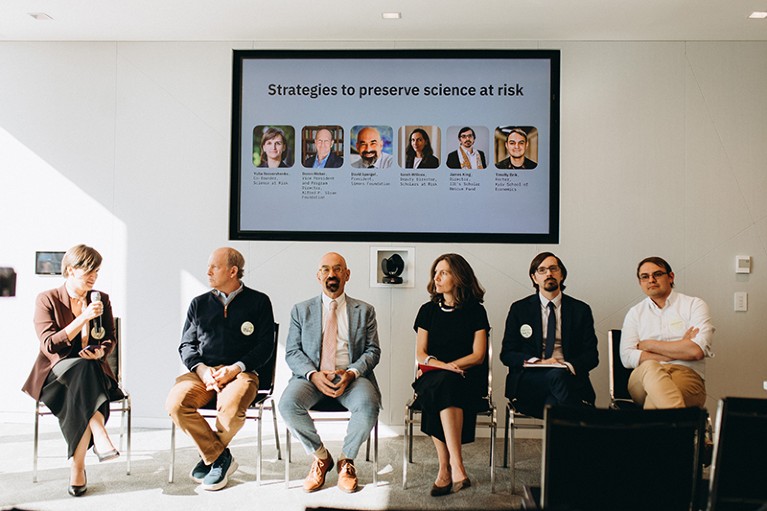
Yulia Bezvershenko (left) was concerned about Ukraine’s lack of preparation to protect science and research.Credit: Scienceatrisk
Those seeking mentors, ranging from early-career researchers to established academics, fill in a form and Potapov and his team then look for appropriate mentors among the branch’s network. Once matched, researchers meet online regularly to discuss research problems and possible collaborations. The mentor might also introduce the other person to a suitable colleague or a specific meeting.
“Some people are looking to expand their network, some are trying to understand how to start publishing in international journals,” says Potapov. “Others are trying to understand how to apply for funding, or are looking for additional support or guidelines.”
Currently, the number of pairs involved is relatively small, with 60 pairs matched so far. But Potapov has been building the capacity to scale up the programme and hopes to increase the numbers tenfold within the next two years.
To do so, Potapov is capitalizing on the UK–Ukraine Twinning initiative coordinated by the Cormack Consultancy Group in Edinburgh, UK, a separate scheme that pairs institutions to encourage ongoing help and collaboration. For example, the University of Liverpool was matched with Sumy State University in Ukraine, in 2022. “We started with immediate things, like providing windows to replace those that had been broken,” says Potapov, “then included more research-based collaborations and provided online settings for teaching.”
More than 100 pairs of UK and Ukrainian institutions have now been twinned. Potapov and his team have already signed up six of them to the mentoring scheme and plan to approach the rest, starting late this year.
Harnessing global Ukrainians
As well as supporting scientists who have remained in Ukraine, rebuilding the country’s science will need the knowledge and energy of those who have left.
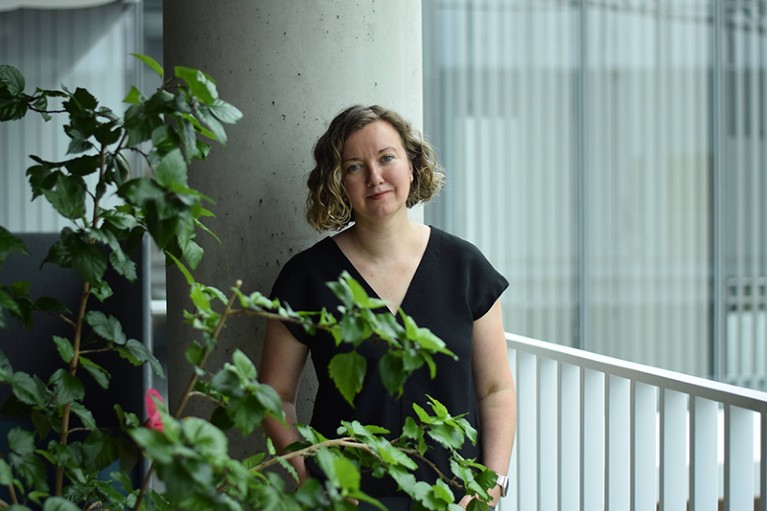
Sanita Reinsone started #ScienceForUkraine soon after Russia’s invasion of Ukraine.Credit: Inga Pizāne
The precise number of those who have left is hard to ascertain. As Yevheniia Polishchuk, an economist at Kyiv National Economic University and co-founder of Ukrainian Science Diaspora, says, “Nobody asks if you’re a scientist when you’re crossing the border.” However, various surveys have estimated that 3,000–7,000 Ukrainian researchers (5–12%) are now living abroad. Ukrainian Science Diaspora works to ensure that these scientists are connected to research in their homeland and united in their efforts to gather support from their adopted countries.
The initiative began in autumn of 2022 with a survey of Ukrainian researchers living abroad and a series of meetings and workshops led by the Young Scientists Council at the Ministry of Education and Science in Ukraine, of which Polishchuk was then deputy head. It found that Ukrainian scientists in some countries, such as the United States, Canada and Germany, had formed online communities. But Polishchuk and historian Igor Lyman, who was at Berdyansk State Pedagogical University in Ukraine, before being forced to leave the country, founded Ukrainian Science Diaspora to enable displaced Ukrainian scientists to connect with each other and their home research institutes.
In February 2023, students from the Massachusetts Institute of Technology in Cambridge, helped to develop a Ukrainian Science Diaspora website with a map showing the locations of more than 200 displaced Ukrainian scholars around the world. The website shows contact details and information about their areas of research. As with Science at Risk’s database, the aim is to encourage research collaborations, but Polishchuk also wants to deepen connections beyond research: “Science is about networking, and scientists abroad have their network of foreign scientists who also can contribute to rebuilding the country.”
Ukrainian Science Diaspora also runs a channel on the app Telegram Messenger for exchanging information about scientific meetings or support schemes. “It’s more informal communication, and every day we have one or two messages about proposals for Ukrainian scientists outside Ukraine,” says Polischuk. “For example, they are searching for partners for their Horizon Europe or Erasmus projects.”
The organization is in the process of launching a mentoring initiative too, pairing established Ukrainian scientists abroad with early-career researchers who have remained in the country. Collaborations can then form either through mentors and the people they mentor working on a publication together, or through mentors making introductions to members of their international network.
This ethos of cooperation underpins all of Ukrainian Science Diaspora’s work. Rebuilding Ukrainian science is not just about giving money or resources for infrastructure, but is also about ensuring that the country capitalizes on the knowledge and connections of its displaced scientists. As Polischuk puts it, “We have to apply all of our intellectual power and ‘human capital’, let’s say. It doesn’t matter where the person is located, it has to be focused on rebuilding.”

